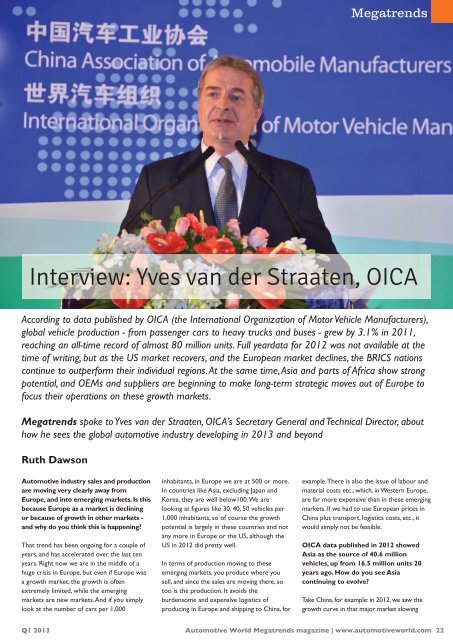megatrends
megatrends
megatrends
You also want an ePaper? Increase the reach of your titles
YUMPU automatically turns print PDFs into web optimized ePapers that Google loves.
Megatrends<br />
Interview: Yves van der Straaten, OICA<br />
According to data published by OICA (the International Organization of Motor Vehicle Manufacturers),<br />
global vehicle production - from passenger cars to heavy trucks and buses - grew by 3.1% in 2011,<br />
reaching an all-time record of almost 80 million units. Full yeardata for 2012 was not available at the<br />
time of writing, but as the US market recovers, and the European market declines, the BRICS nations<br />
continue to outperform their individual regions. At the same time, Asia and parts of Africa show strong<br />
potential, and OEMs and suppliers are beginning to make long-term strategic moves out of Europe to<br />
focus their operations on these growth markets.<br />
Megatrends spoke to Yves van der Straaten, OICA’s Secretary General and Technical Director, about<br />
how he sees the global automotive industry developing in 2013 and beyond<br />
Ruth Dawson<br />
Automotive industry sales and production<br />
are moving very clearly away from<br />
Europe, and into emerging markets. Is this<br />
because Europe as a market is declining<br />
or because of growth in other markets -<br />
and why do you think this is happening?<br />
That trend has been ongoing for a couple of<br />
years, and has accelerated over the last ten<br />
years. Right now we are in the middle of a<br />
huge crisis in Europe, but even if Europe was<br />
a growth market, the growth is often<br />
extremely limited, while the emerging<br />
markets are new markets. And if you simply<br />
look at the number of cars per 1,000<br />
Q1 2013<br />
inhabitants, in Europe we are at 500 or more.<br />
In countries like Asia, excluding Japan and<br />
Korea, they are well below100. We are<br />
looking at figures like 30, 40, 50 vehicles per<br />
1,000 inhabitants, so of course the growth<br />
potential is largely in these countries and not<br />
any more in Europe or the US, although the<br />
US in 2012 did pretty well.<br />
In terms of production moving to these<br />
emerging markets, you produce where you<br />
sell, and since the sales are moving there, so<br />
too is the production. It avoids the<br />
burdensome and expensive logistics of<br />
producing in Europe and shipping to China, for<br />
example. There is also the issue of labour and<br />
material costs etc., which, in Western Europe,<br />
are far more expensive than in these emerging<br />
markets. If we had to use European prices in<br />
China plus transport, logistics costs, etc., it<br />
would simply not be feasible.<br />
OICA data published in 2012 showed<br />
Asia as the source of 40.6 million<br />
vehicles, up from 16.5 million units 20<br />
years ago. How do you see Asia<br />
continuing to evolve?<br />
Take China, for example: in 2012, we saw the<br />
growth curve in that major market slowing<br />
Automotive World Megatrends magazine | www.automotiveworld.com<br />
22


